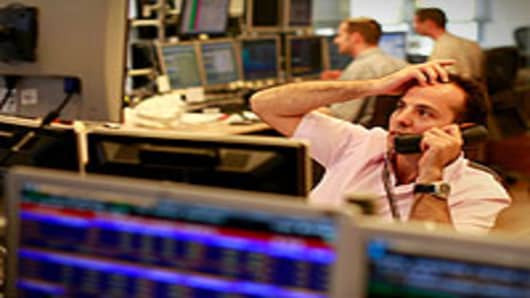From a wobbly economy to escalating oil prices to global unrest, the stock market has all the classic reasons to correct, yet remains on a stubborn path higher.
But with each passing milestone eclipsed, each fresh two-year high reached andeach sign that corporate America is getting back on its feetcomes reason to believe that a significant pullback lurks and just needs that next catalyst.
The question now seems only a matter of timing and degree. As for strategy, even those with the most dour of outlooks say a pullback will present a buying opportunity, while selling into strength may not be the best strategy in a market considered likely to bounce back.
Standard & Poor's, for one, is predicting that its benchmark index, the S&P 500 , is likely to drop up to 10 percent in the next two weeks, based on a variety of factors both technical and fundamental. It is boldest forecast yet from a leading firm that the current market is overheated.
"Despite the hoopla over the (Dow industrials) eclipsing 12,000 and the S&P 500 nearing 1,300, we see widening cracks in the dam," Sam Stovall, S&P's chief equity strategist, said in an analysis for clients. "Many global indices have failed to follow the DJIA and 500 during the last week, and we see this as a major warning that a pullback or correction is near."
There are several other reasons Stovall said he is looking for a pullback, among them overly bullish sentiment and weak internals.
On some investors' minds, though, is the uprising in Egypt that sent stocks plungingmore than 10 percent in Thursday's trading. The unrest came as the region also was reeling from the overthrow of governments in Tunisia and Lebanon.
Notably, oil prices have remained within their recent trading rangedespite the turmoil. But worries remain that a disruption in crude production will spill over into the equities markets.
"The Middle East is really going in the wrong direction big-time. That means oil," said Uri Landesman, president of Platinum Partners in New York. "The odds of an oil spike this year well over $100 (a barrel) in the $125 to $130 range remains very possible given the almost-wild radicalization going on the area."
On a technical basis, Landesman sees 1,305 a key technical level for the S&P 500, with a breakout higher to 1,337 or lower to 1,230 to follow.
Because of the uncertain state of employmentand housing, coupled with the international threat, Landesman thinks a move to the downside is more likely, with a 6 percent pullback looming.
"If we end up with a whole series of theocracies surrounding Israel, it does not portend well for Middle East peace," he said. "I do not believe the S&P can hold up under $120 oil. It's going to really put a crimp in industrial production."
Landesman recommends investors "be patient" in a market likely to present volatility ahead.
At the same time, S&P, with its full-year 1,370 target, thinks investors ought to pursue a cyclical sector strategy, with an overweight on industrials, information technology and materials, while underweighting health care and utilities.
That's reflective of a view that even if the US economy sputters global growth will continue to be a driver in a market that is 90 percent off its March 2009 financial crisis lows.
It also shows faith in a stubborn market pushed by traders who hold the sentiment that even if all else fails, the Federal Reserve with its liquidity programswill be there to backstop the market until it no longer can.
"The Fed is now targeting the stock market and engaging in some form of manipulation to invite the same speculative risky behavior that ended so badly in the past," David Rosenberg, economist and strategist at Gluskin Sheff in Toronto, wrote in an analysis earlier this week. "But make no mistake, (Fed Chairman Ben Bernanke) is spiking the Kool-Aid in a significant way and it is working for now."
Indeed, despite the various obstacles that might have triggered a market relapse otherwise, the averages are closing out a solid January with gains of more than 2 percent.
"There are people out there who want to buy stocks," said Justin Wiggs, vice president of trading at Stifel Nicolaus in Baltimore. "You're fighting against the trend right now when you're trying to play the pullback."
The only problem for some advisors, in fact, is to convince their clients that the market is back on solid ground.
Domestic equity mutual funds recently broke an eight-month losing streak and posted positive inflows for the second consecutive week, though in fairly tepid fashion. Inflows stood at $2.97 billion for the week ended Jan. 19, according to the Investment Company Institute.
"American business and American investors are playing defense today," says Rob Lutts, chief investment officer at Cabot Money Management in Salem, Mass. Lutts sees a likely pullback of 5 to 8 percent in the first half of the year that will create an entry point for reluctant investors.
"The market are focusing on six to 12 months from now. What they're seeing is a better economy, a better environment and better earnings," he said. "Every day the S&P 500 wants to grind higher."



